To celebrate the International Day of Forests in 2022, I want to explain the latest developments regarding Bamboologic in Europe. I am advisor to the company, and help to share achievements and lessons learned.
Bamboo is a collective name for a group of botanical species that all belong to the grass family, the Graminea. The term applies both to the living plant and to the products made from the plant. Current estimations are that more than 1600 different varieties of bamboo exist, and out of these there are some 1500 woody bamboos. The woody bamboos look like trees and they can reach up to 35 metres in height. Some species can have 20 cm thick stems, while the smallest types are bushes that are not even 1 cm in diameter.
Bamboos occur naturally in most countries along the (sub-)tropical belt. Brazil, China and India have the largest areas of natural bamboo of a global bamboo cover that I have estimated to be nearly 50 million hectares. Europe has no endemic bamboos, although some of the plants grow well in the temperate climate, and there are well established bamboo gardens in France, Italy, Portugal and Spain.
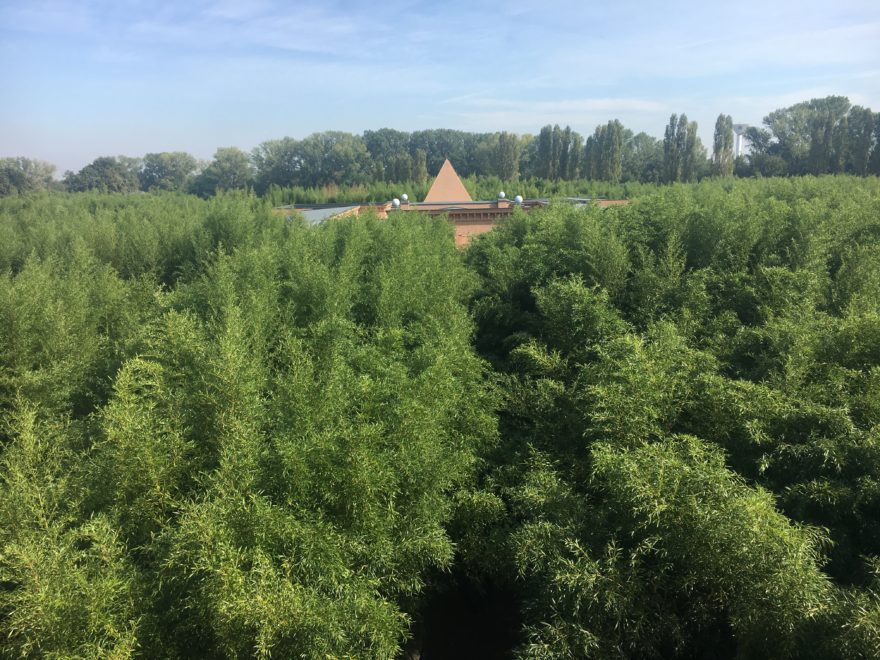
labirinto della masone in Italy
Extensive bamboo plantations currently only exist in China, where some 3 to 4 million hectares of bamboo have been planted during the past decades. This has fueled a domestic bamboo economy in the order of 60 billion USD per annum. A few individual plantations have been created in other typical bamboo countries, and Bamboologic is developing bamboo fields in southern Europe, starting in Portugal.
Bamboo plants have an extensive root system that includes roots and underground parts called rhizomes from which the above-ground stems sprout, and one plant will have many stems, which are called culms. The rhizome system is either formed as a clump, with the culms forming a cluster of poles, or the rhizomes form individual underground root-systems with culms sprouting at irregular intervals. Bamboos of the first type are called clumping bamboos and the latter are the running bamboo species. The extensive rhizome networks help to hold soil in place and assist in soil water management, making bamboo particularly suitable for reforestation on poor grounds, erosion control and landscape management.
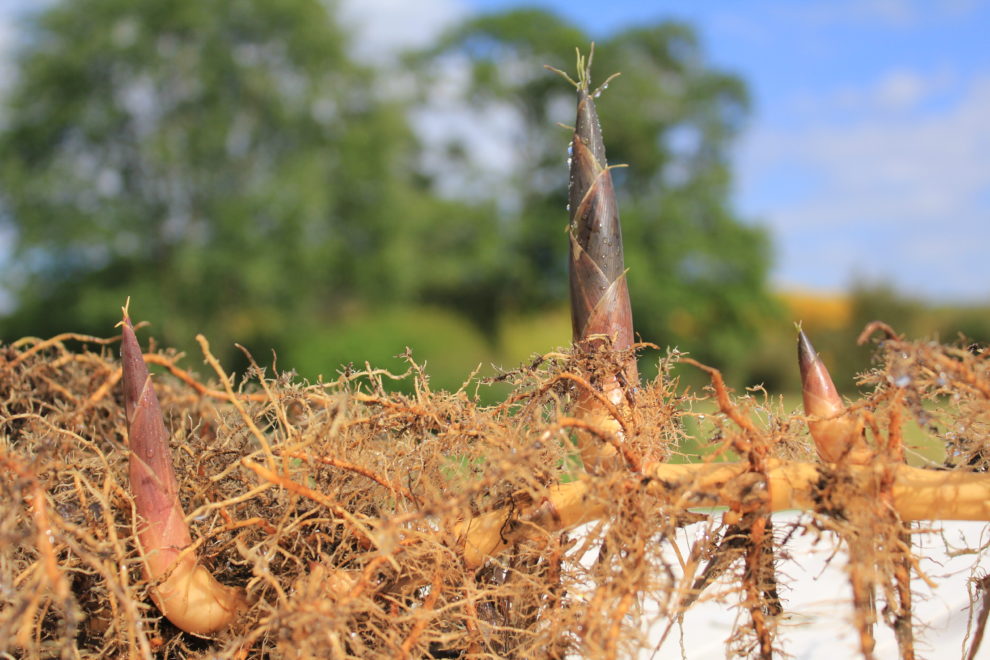
Running bamboo rots and rhizomes
Bamboo and carbon sequestration
One of the most striking features of bamboo is its amazing speed of growth, and new shoots that emerge from the soil during the growing season reach their full length within a couple of months. The maximum recorded growth of Moso bamboo in China is up to 1 metre per day, which makes bamboo the fastest growing plant in the world.
Because of its fast growth, the plant absorbs a considerable amount of CO2 from the atmosphere, providing oxygen in return, and bamboo plantations are known to be more effective carbon sinks than some tree plantations. Much of the carbon is locked in the underground rhizome system of the natural system, and if bamboo poles are used for the manufacturing of durable goods, more carbon is locked in for a long time. Moreover, bamboo products can often be used as alternatives to products that produced CO2 during production, which adds to the value of bamboo forests for climate change mitigation.
Bamboo harvesting and production
The new bamboo culms harden through lignification, and after some 5 to 7 years the culms are mature and they can be harvested for use. In general, one quarter to one third of the poles in a forest or plantation can be sustainably harvested annually without decreasing the viability of the plantation or the forest. In fact, the rhizomes do not die after harvesting and by sustainably harvesting the mature poles, the annual yield of the plantation actually increases.
Although bamboo is often considered an aspect of forestry, a bamboo forest is best managed as an agricultural crop, with a pre-determined annual harvesting scheme. The Bamboologic plantations in southern Europe are managed accordingly, and we expect the poles to be used for construction and interior design, and for the production of fibre for clothing and composites.
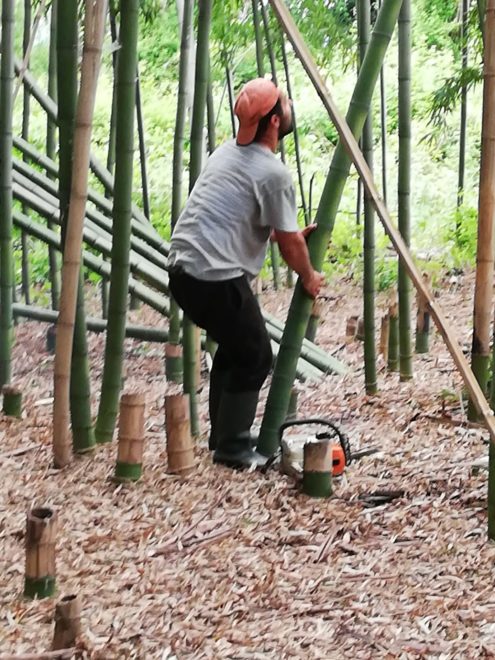
Bamboologic bamboo field in southern Portugal
The need for further research
As this is the first large-scale industrial development of bamboo resources in Europe, there is need to carry out research on the viability and efficiency of planting different species. I am a member of the Steering Committee of a new research project, managed by ArtEZ University of the Arts in the Netherlands, that aims to find answers to a number of the questions. Six specific research packages have been identified for a consortium of partners:
- To determine mechanical and chemical properties of European bamboo and its waste products. This includes considerations about the efficiency of harvesting and the options for development of waste products into value chains. Several consortium partners will be involved
- The potential uses of half-finished products in interior design and construction. This work package will potential value chains for semi-finished products with the involvement of all consortium partners.
- Research on the use of bamboo cellulose for textile production, which includes studies and tests on chemical and mechanical fibre extraction methodologies. One of the key partners will be Miscancell, a company that specializes in the extraction of cellulose from Miscanthus grass.
- How to upgrade half finished products into market-ready finished items? This study will look into the suitability of available tools and machines and address the need for appropriate manufacturing standards. One specific aspect will be further research on bio-based coatings, in partnership with Inducoat, a market leader in the development of environmentally friendly coatings for wood.
- Testing the market potential of specific bamboo products. This will involve market research with a group of producers who will be identified through the network of consortium partners, and a consumer-focused outreach programme, with help from the Netherlands Open Air Museum.
- Identification of new and potentially lucrative value chains based on European bamboo with the involvement of all consortium partners.
In a separate programme, Bamboologic is exploring the best way of using bamboo for carbon sequestration and carbon offsets, and we are working with the Dutch Open Natural Carbon Removal Accounting platform ONCRA to create a transparent and efficient carbon offset system.
News from the field and future planning
Bamboologic owns some mature bamboo fields in Portugal, and recently the Phyllostachys has started to shoot. We are selling shoots to local Chinese restaurant owners, who use the shoots in their menu.
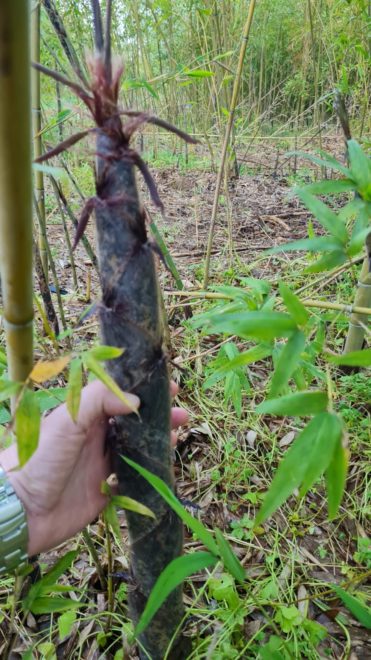
New bamboo shoot in March 2022
We have only just started planting on the newly acquired land in Alcoutim, but the fields are growing, and we are planting more new bamboos, supplied by Vista Verde in Belgium. During a recent visit to the nursery in Merksplas, I had the opportunity to see some of the new plants, including this Farghesia Robusta Pingu.
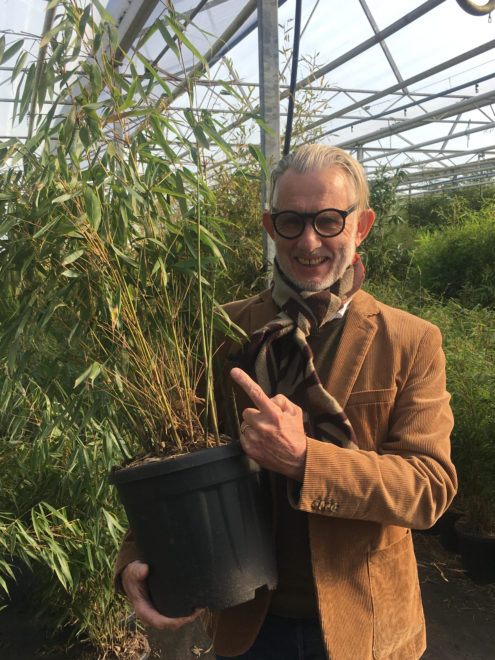
The author will a pot of Farghesia robusta pingu
Bamboologic’s plan is to upscale the current planting activities in Portugal and expand into Spain and other European countries. We will continue to test new ideas and to expand the carbon offsets programme. In parallel, we will construct the infrastructure required to start production of several value chains. Together with partner organisation, joint ventures will be established to create jobs, improve the local landscape, and help to reduce the footprint of the localities where we are working.

0 comments
Write a comment